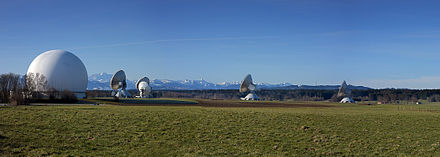Satellite radio

Satellite radio includes all radio applications that are required for technical communication via or with satellites or satellite-supported networks . The radio stations , receiving systems and feed connections used may use frequency ranges that are assigned to the corresponding radio services . The radio link to satellites in orbit is limited by the opacity of the ionosphere, i.e. the ability of the electromagnetic wave of the earth's atmosphere to penetrate in order to reach satellites in orbit. Conversely, without a reflection of the electromagnetic wave on the layers of the atmosphere, due to the curvature of the earth, a direct radio link across the globe from, for example, Berlin, Germany to Cape Town, South Africa would not be possible.
Satellite broadcast applications and systems
Satellite radio includes a. the following applications and systems:
| No. | Radio application | description |
|---|---|---|
| 1 | Satellite radio system | Space radio system in which one or more artificial earth satellites are used. |
| 2 | Space radio system | |
| 3 | Satellite radio network | |
| 4th | Satellite radio connection | |
| 5 | Feed connection |
Radio stations
In satellite radio u. a. the following radio stations are used.
| No. | Radio station | description |
|---|---|---|
| 1 | Earth station | |
| 2 | Space station | |
| 3 | Mobile earth station | |
| 4th | Fixed earth station | Fixed radio service earth station via satellite |
| 5 | Fixed land radio station | Fixed radio station of the mobile land radio service |
| 6th | Fixed land radio station | Fixed radio service earth station via satellite |
| 7th | Land service mobile earth station via satellite | |
| 8th | Coastal earth station | Earth station of the remote radio service via satellite |
| 9 | Ship earth station | |
| 10 | Ground radio station | Fixed radio service earth station via satellite |
| 11 | Aircraft earth station | mobile earth station of the mobile aeronautical radio service via satellite on board an aircraft |
| 12 | Satellite radio beacon to identify the emergency position |
history
In 1929 Herman Potočnik's book The Problem of Navigating Space - The Rocket Motor appeared under the pseudonym Hermann Noordung , where he describes the idea of placing space stations and satellites in geostationary orbit .
In 1945 the article Extra-terrestrial Relays was published in the scientific journal Wireless World , in which the British Arthur C. Clarke took up the idea of using geostationary satellites for technical communication. On October 4, 1957, Sputnik 1 was the first artificial satellite to be sent into orbit by the USSR . On January 23, 1962, the Telstar communications satellite broadcast the first television broadcast from the United States to Europe . Since Telstar had an elliptical orbit, the transmission only took a few minutes. In 1963 the USA succeeded in placing the first communications satellite in geosynchronous orbit with the Syncom project.
In 1965, the first commercial, geostationary communications satellite, Intelsat 1 (nicknamed Early Bird), went into operation. Communication took place point-to-point between two earth stations with 30 m parabolic antennas. In 1974 the US ATS 6 (Applications Technology Satellite) broadcast training programs to approximately 2,400 villages in India. Antennas were 3 m large parabolic mirrors made of wire mesh ( wind load ).
In 1978 ESA launched its first communications satellite, the Orbital Test Satellite . In 1979 there was a television broadcast from France to Tunisia with 3 m parabolic antennas. Eutelsat was founded in 1982 to market and operate European communications satellites. On December 1, 1984, the German-language satellite cultural program 3sat went into operation.
In 1989 ASTRA 1A , DFS Kopernikus 1 and TVSat 2 started broadcasting. In 1991 satellite reception in Austria did not require a permit. 1995 started Eutelsat, HotBird , digital television broadcasting and digital radio ( Astra Digital Radio (ADR)). Internet access has been possible via satellite in the downlink direction since 1997 .
See also
Individual evidence
- ↑ for Germany: Frequency Ordinance of August 27, 2013 (Federal Law Gazette I 2013, 3326)
- ↑ Section IV, Radio Stations and Radio Systems, Frequency Range Allocation Plan for the Federal Republic of Germany ... g, p. 17